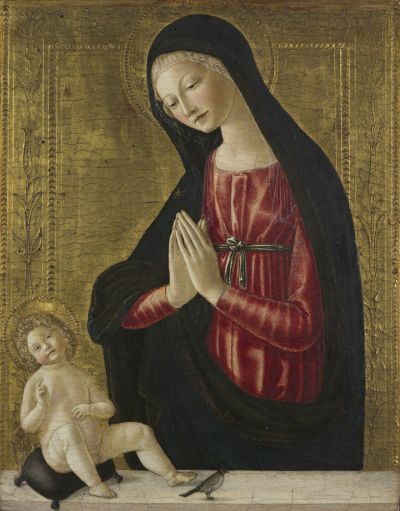Neroccio de’ Landi fu pittore e scultore del primo Rinascimento a Siena. In entrambe queste arti figurative egli fu allievo del Vecchietta, di cui rilevò la bottega nel 1480, ma dal 1469 circa al ‘75 fu anche socio di Francesco Martini, forse limitatamente al solo campo della pittura. Le sue opere pittoriche sono caratterizzate dai colori delicati e trasparenti, dalle figure intrise di un sentimento musicale ma anche dalla capacità di far incontrare armonicamente la tradizione gotica senese con il nuovo spirito e con i valori propri dell’umanesimo. Neroccio fu artista prolifico ma attivo quasi esclusivamente a Siena o nel contado e per una committenza minore. Dell’artista, il Museo di Arte di Cleveland annovera nella propria collezione la Madonna col Bambino e un Cardellino, opera databile intorno al 1490.
Among the great medieval Italian cities that are well-represented in the collections of the Cleveland Museum of Art is the Tuscan city of Siena. Tourists who visit Siena today will marvel at its richly preserved medieval streets, its famed Duomo and the Piazza del Campo. For anyone approaching the city from the south along the via Francigena, along which thousands of pilgrims passed on their way from northern Europe to Rome in the Middle Ages, the city still appears much as it did in the 1400s. From this perspective, the traveler will note the city’s red brick walls. Siena is situated on the ridges of three hills from which its turrets and towers can be observed from afar. In the 15th century, as now, the vista would have been dominated by the black and white striped campanile of the cathedral, the crenellated Torre del Mangia of the Palazzo Pubblico and the bell tower of Santa Maria dei Servi. This view leaves a lasting impression on those who have experienced it.
Those who wish to explore Siena’s important contribution to art without extensive travel may alternatively visit the Cleveland Museum of Art. There, examples of Sienese paintings from the Trecento and Quattrocento illustrate this city’s enduring legacy in the history of art. In a previous article we discussed the impact of the plague, the so-called “Black Death” on art and artists. In 1348, the visitation of plague was particularly brutal for Siena by reducing its population by an estimated two-thirds. Until then, Siena was one of the largest and wealthiest cities in Europe. The city never recovered its former economic or cultural position. It is recognized that Sienese painters like Duccio, Simone Martini and Pietro and Ambrogio Lorenzetti, all active before the plague, were among the greatest innovators of European painting. However, none of these great masters survived the Black Death. Artists and their patrons struggled in the aftermath of this horrific event to revive their artistic traditions.
In the 15th century, commissions in Siena remained largely ecclesiastical or communal and several new generations of painters eventually became prominent. These included Giovanni di Paolo, Sano di Pietro, Sassetta, Francesco di Giorgio, called Vechietta, and Neroccio de’Landi. Establishing a viable career must have been difficult for those with artistic ambitions at the opening of the new century. Evidence of a lost and glorious past was everywhere. Duccio’s “Maestà” still remained on the cathedral’s high altar. Within the chapels of its transepts were works by Pietro Lorenzetti, Simone Martini and others. The outcome was that many artists were able to exploit this rich heritage by recognizing that native traditions of Sienese art were still capable of further development. The painter Sassetta, for example, was capable of further refining the pictorial spaces of the Lorenzetti brothers by painting vistas onto monastic courtyards or the interiors of conventual churches.
Visitors to museums with great collections of Italian art will observe the abundance of paintings representing the subject of the “Madonna and Child.” In Siena this was emblematic perhaps of the city’s particular affection for the Virgin Mary. On the eve of the Battle of Montaperti in 1260, the city of Siena was officially dedicated to the Virgin. Siena’s miraculous victory over its Florentine opponents the following day confirmed its status as the Civitas Virginis or “City of the Virgin” and inspired in its citizens fervent devotion to their heavenly protectress. Marian imagery flourished and many altarpieces comprising images of the Madonna and Child flanked by saints were in constant demand for Sienese churches and civic buildings providing a livelihood for many artists of the time. Today, many of these altarpieces have survived only in fragmentary condition, their individual panels having been separated by history and often represented by solitary surviving panels of the Madonna and Child.
This desire for images of Mary extended well beyond the plague’s arrival into the 1400s. One such compelling work from this later period of Sienese painting is the “Madonna and Child with a Goldfinch” of about 1490 by Neroccio de’Landi (1447-1500) now in the Cleveland Museum of Art. Neroccio di Bartolomeo de’ Landi was both a painter and sculptor. He is mentioned as an artist in a document of 1468, shortly after which he entered into a partnership with an older contemporary, Francesco di Giorgio, under whom he likely trained. The two are presumed to have worked together into the mid-1470s. Neroccio developed an elegant and delicate figure style and a pale and soft palette of colors, which he used with little variation during the last quarter of the century. Neroccio is considered by many to be a Madonna painter par excellence. Much of his activity as a painter centered on the production of devotional panels of the Madonna and Child. These must have been the primary source of his livelihood as a painter. His aristocratic images were much appreciated in his time and he is perhaps among Siena’s last great painters of the late 1400s.
While 15th-century Sienese painters truly stood on the shoulders of giants, the artists who flourished before the Black Death, many, like Neroccio, painted some of the most elegant and captivating works of the era.



